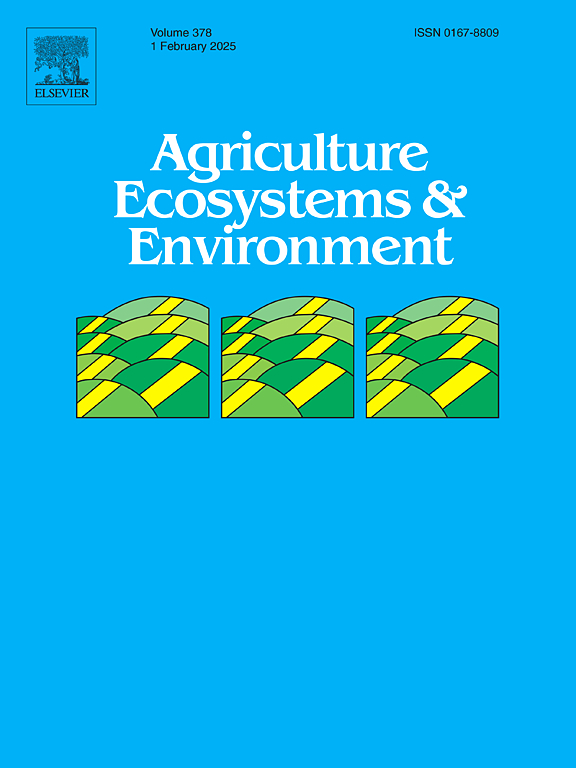Grazing legacy mediates the diverse responses of grassland multidimensional stability to resource enrichment
IF 6
1区 农林科学
Q1 AGRICULTURE, MULTIDISCIPLINARY
引用次数: 0
Abstract
Long-term grazing and resource enrichment are known to affect grassland ecosystem stability independently. However, the interactive effects of grazing legacy and resource enrichment on ecosystem multidimensional stability (e.g., temporal stability (TS): the degree of constancy of ecosystem components over time and temporal resistance (TR): the ability of ecosystem components to withstand the environmental change) in grassland ecosystems remain underexplored. In this study, we conducted a field manipulation experiment to assess the impact of 4-yr of resource addition (water and nitrogen) on multidimensional stability of multiple ecosystem components and underlying drivers in Inner Mongolia steppe with 7-yr different experimental grazing history. We found that the positive effects of water + nitrogen addition on multifunctional TS increased with increasing grazing intensity and an opposing trend was observed for multifunctional TR response. However, neither grazing legacy nor resource addition had an effect on community compositional stability. Resource addition enhanced the stability of species evenness, CWM (community weighted mean) species biomass and CWM-traits. Furthermore, water + nitrogen additions stimulated soil temperature TS but reduced its TR in heavy grazing intensity, with high grazing intensity bolstering soil moisture stability. Multifunctional stability was primarily governed by species asynchrony, while stability of species evenness fostered compositional stability. In particular, TS of functional diversity enhanced multifunctional TS in light grazing intensity, while TS of CWM-traits promoted multifunctional TS in heavy grazing intensity. Our study underscores the decoupling responses of functional stability and compositional stability to grazing legacy combined with resource enrichment. These findings highlight that the significance of concurrently considering multiple stability dimensions and components for a comprehensive understanding of grassland ecosystem stability under intensifying land use and global change scenarios.
放牧遗存介导草原多维稳定性对资源丰富性的不同反应
众所周知,长期放牧和资源富集会单独影响草原生态系统的稳定性。然而,放牧遗存和资源富集对草原生态系统多维稳定性(如时间稳定性(TS):生态系统成分随时间变化的恒定程度和时间抵抗力(TR):生态系统成分抵御环境变化的能力)的交互影响仍未得到充分探索。在本研究中,我们进行了一项田间操作实验,以评估在内蒙古草原不同放牧历史的 7 年实验中,4 年的资源添加(水和氮)对生态系统多种成分的多维稳定性和潜在驱动因素的影响。我们发现,随着放牧强度的增加,水和氮的添加对多功能TS的正效应增加,而多功能TR的响应则呈相反趋势。然而,放牧历史和资源添加对群落组成的稳定性都没有影响。资源添加增强了物种均匀度、CWM(群落加权平均值)物种生物量和 CWM 特征的稳定性。此外,水和氮的添加刺激了土壤温度TS,但降低了重度放牧强度下的土壤温度TR,而高放牧强度则增强了土壤湿度稳定性。多功能稳定性主要受物种异步性的影响,而物种均匀性的稳定性则促进了成分稳定性。特别是,功能多样性的TS增强了轻度放牧强度下的多功能TS,而CWM-特征的TS则促进了重度放牧强度下的多功能TS。我们的研究强调了功能稳定性和组成稳定性对放牧遗存与资源富集的脱钩反应。这些发现突出表明,同时考虑多个稳定性维度和成分对于全面了解土地利用加剧和全球变化情景下的草原生态系统稳定性具有重要意义。
本文章由计算机程序翻译,如有差异,请以英文原文为准。
求助全文
约1分钟内获得全文
求助全文
来源期刊

Agriculture, Ecosystems & Environment
环境科学-环境科学
CiteScore
11.70
自引率
9.10%
发文量
392
审稿时长
26 days
期刊介绍:
Agriculture, Ecosystems and Environment publishes scientific articles dealing with the interface between agroecosystems and the natural environment, specifically how agriculture influences the environment and how changes in that environment impact agroecosystems. Preference is given to papers from experimental and observational research at the field, system or landscape level, from studies that enhance our understanding of processes using data-based biophysical modelling, and papers that bridge scientific disciplines and integrate knowledge. All papers should be placed in an international or wide comparative context.
 求助内容:
求助内容: 应助结果提醒方式:
应助结果提醒方式:


